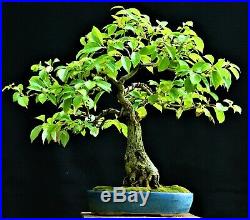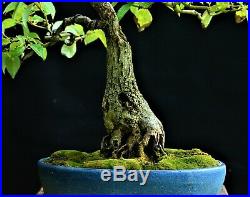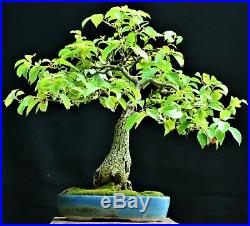



Nepal Camphor Tree (Cinnamomum glanduliferum) bonsai – medium size. Height: 21 inches; Width: 24 inches. Pot size 14″ X 9″ X 3 Pot origin: Dick Ryerson, Los Angeles potter. Trunk diameter at the root base: 5 inches. Popular name: Nepal Camphor Tree. A stately evergreen tree, growing up to 66 feet (20 m), native of Nepal, Bhutan, India, China, Malaysia. The leaves contain essential oils, and camphor – the substance used in Vix and other ointments to cure respiratory problems. It grows in high elevation tropical forests, and mountains, sometimes as high as 9,000 feet. I grew this tree from a seedling collected on our street, in Alhambra, CA. Most of its live I kept it in the ground, until it developed a large trunk. Developing into a bonsai wasn’t an easy task. As a tree, it is as tough as nail, and it forgives every mistake that one can make. But it was very reluctant to respond to bonsai techniques. At the end, though, I feel that the tree just “gave in” to bonsai training, and started responding better and better. Now it’s really “tame”, and its foliage is taking on the characteristic of a good bonsai. The challenge with Cinnamomum, is to reduce the internodes, and leaf-size. This can be done easier, when the branches are thicker, and then pruned back hard. When we do this, new buds develop everywhere, and those tend to produce higher quality foliage. But to get thick branches, one has to let the original branch grow freely. The problem with that, is that the more we let it grow, the longer the inter-nodes get. So, it’s kind of a Catch-22. The other challenge is, that if we don’t prune it the way it should be pruned, some branches will die back. This is characteristic of many fast-growing broad-leaf trees (such as birch, alder, etc), and the Camphor behaves the same way. To avoid that, younger branches need to be pruned back to places where a bud is forming, and we also need to distribute the energy of the tree correctly. Old and thick branches, on the other hand, can be pruned back hard. They do not usually die back. I already solved these challenges, and developed strong primary and secondary branches. The new owner will have an easier task, taking it from here. Once this bonsai passes a tipping point, and has enough well-ramified branches, it starts responding better to pruning. The inter-nodes are shorter, and the leaves are smaller. Going forward, one needs to be diligent in pruning the new foliage, and quickly removing any growth that shows long inter-nodes. It is potted in a Dick Ryerson pot that complements very well the tree. This is a tree for the adventure-seeker bonsai enthusiast. It is very common as a street tree in Southern California, and very rare, in bonsai culture. I feel that it could become a popular bonsai subject, if we learned more about the species, and how to train it as a bonsai. With age, it develops beautiful old bark, nice foliage, and can survive even the most common bonsai mistakes. I once tried to kill such a tree in my backyard, because it was in the wrong place, and I needed the space. I tried for two years, but the tree won, at the end. The item “Nepal Camphor Tree (Cinnamomum glanduliferum) bonsai medium size” is in sale since Wednesday, November 13, 2019. This item is in the category “Home & Garden\Yard, Garden & Outdoor Living\Plants, Seeds & Bulbs\Plants & Seedlings\Bonsai”. The seller is “world_of_bonsai” and is located in Altadena, California. This item can be shipped to United States.
- Aspect: East-facing
- Bonsai Species: Cinnamomum glanduliferum
- Plant Form: Finished Bonsai
- Type: Semi-tropical evergreen
- Climate: Sub-tropical
- Sunlight: Full Sun
- USDA Hardiness Zone (°F): 9 (20 to 30 °F)
- Genus: Cinnamomum
- Foliage: Broadleaf Evergreen
- Indoor/Outdoor: Outdoor
Tags: bonsai, camphor, cinnamomum, glanduliferum, medium, nepal, size, tree
0